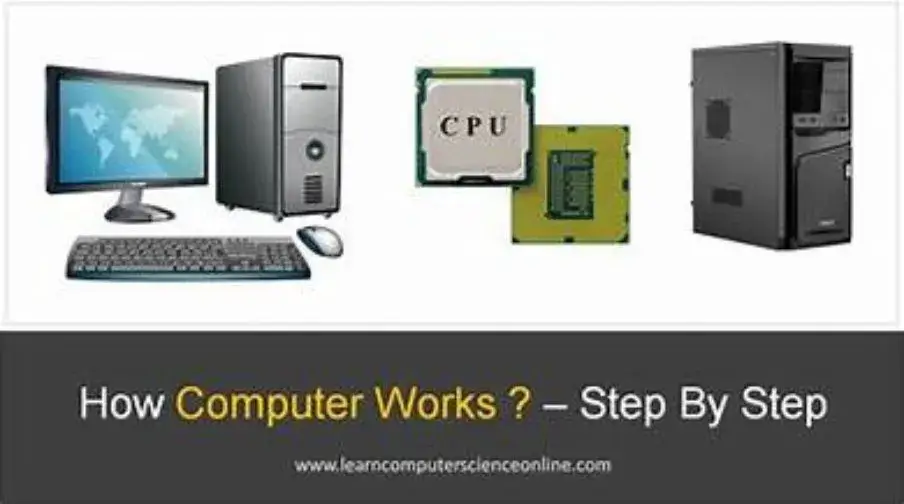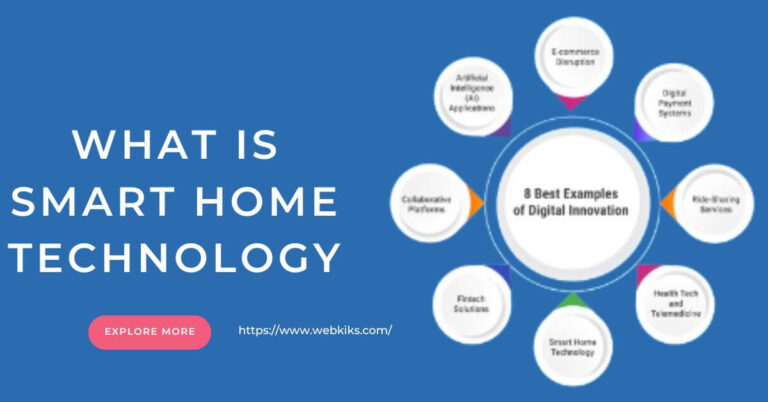Computers are fascinating machines that have become essential in our daily lives. They help us perform complex tasks, entertain us, and connect us with the world. But how exactly do computers work? Let’s break it down.
What Is A Computer?
A computer is an electronic device that makes and stores information. It can perform various tasks, from simple calculations to complex simulations. Computers have become important to our lives, helping us work, learn, communicate, and entertain ourselves. But what exactly is a computer, and how does it work? Let’s explore.
At its core, a computer is a machine that can make to carry out a sequence of operations automatically. These operations are performed according to instructions given by software programs. The computer takes in data, processes it, stores it, and outputs the results.
Importance of Computers In Today’s World
Computers have become a major part of our daily lives, influencing nearly every aspect of society. Their impact is profound, from business to education, healthcare to entertainment. Here’s why computers are so important in today’s world.
1: Education And Learning
Computers have revolutionized education by making information easily accessible. Students can access vast knowledge online, attend virtual classes, and use educational software to enhance their learning. Computers also enable distance learning, allowing students worldwide to pursue education without being physically present in a classroom.
2: Business And Industry
Computers are indispensable in the business world. They help companies manage operations, store data, and communicate efficiently. Businesses use computers for accounting, inventory management, customer relationship management (CRM), and marketing. Automating routine tasks through computers increases productivity and decreases human error, leading to more efficient and profitable operations.
3: Communication
Computers have transformed the way we communicate. Email, social media, video conferencing, and instant messaging are all made possible through computers. This has not only connected people globally but also made communication faster and more convenient. Businesses, friends, and families can easily stay in touch, no matter the distance.
4: Healthcare
In healthcare, computers play a critical role in patient care and management. They store medical records, track patient history, and manage appointments. Computers also power advanced diagnostic tools and medical equipment, helping doctors provide accurate diagnoses and treatments. Telemedicine, which allows patients to consult with doctors remotely, has become increasingly important, especially in areas with limited access to healthcare.
5: Research and Development
Computers are essential in research and development across various fields. Scientists use computers to conduct simulations, analyze data, and model complex systems. This has led to technological advancements, medicine, environmental science, and more. The processing power of computers allows researchers to handle large datasets and perform calculations that would be impossible manually.
6: Entertainment
Computers have revolutionized the entertainment industry. From video games to streaming services, computers provide endless sources of entertainment. They allow for the creation complex graphics, movie special effects, and interactive content development. Computers also enable people to create, edit, and share content, leading to a boom in user-generated media.
7: Security
In today’s digital age, security is paramount, and computers play a crucial role in protecting data. Cybersecurity systems use advanced algorithms and software to protect important information from hackers and other threats. Computers also help monitor and safeguard physical spaces through surveillance systems and automated security protocols.
8: Automation and Innovation
Computers drive innovation by enabling automation and the development of new technologies. They are at the heart of emerging fields like artificial intelligence (AI), machine learning, and robotics. Computer automation is transforming industries, from manufacturing to logistics, by increasing efficiency and reducing costs.
Step-by-Step Guide: How Does A Computer Work?
Learning how a computer works can seem complex, but breaking it down into simple steps makes it easier to grasp. Here’s a step-by-step guide to explain the basic process of how a computer operates.

1: Power On
The process begins when you press the power button on your computer. This action triggers the Power Supply Unit (PSU) to supply power to the computer’s components. The PSU converts electrical energy from your outlet into a form the computer can use.
2: Booting Up (BIOS/UEFI)
Once the computer receives power, it activates the BIOS (Basic Input/Output System) or UEFI (Unified Extensible Firmware Interface), low-level software stored on a chip on the motherboard. The BIOS/UEFI performs a Power-On Self-Test (POST) to check if all hardware components, such as the CPU, RAM, and storage devices, function correctly.
3: Loading the Operating System
After the POST is successful, the BIOS/UEFI looks for a bootable device, usually the hard drive or solid-state drive (SSD), where the operating system (OS) is stored. The BIOS/UEFI loads the OS into the computer’s Random Access Memory (RAM). However, the operating system sets the computer’s resources and gives a user interface to interact with the computer.
4: Input: Receiving Data
When you interact with the computer, for example. So, it is good to type on the keyboard or move the mouse, the input devices send data to the CPU. These actions are converted into digital signals that the computer can understand.
5: Processing: The CPU at Work
The Central Processing Unit (CPU) processes the data received from input devices. It performs calculations, executes instructions from software, and makes decisions. The CPU relies on two main components:
Arithmetic Logic Unit (ALU): Handles mathematical operations and logical comparisons.
Control Unit: This unit directs the CPU’s operations and ensures data flows correctly between the CPU, memory, and other components.
6: Temporary Data Storage (RAM)
As the CPU processes data, it temporarily stores it in RAM. RAM allows the CPU to access data quickly without retrieving it from slower long-term storage. RAM holds the data needed for current tasks, like running an application or editing a document.
7: Executing Software Instructions
Software programs, like word processors or web browsers, provide instructions that the CPU follows to perform tasks. So, the operating system and application software work together to manage these instructions. The CPU processes these instructions step by step, enabling the computer to accomplish the task.
8: Storing Data
If you save a file or document, the data is written to the computer’s long-term storage (a hard drive or SSD). So, this non-volatile storage means the data remains intact even when the computer is turned off.
9: Output: Displaying Results
After processing the data, the CPU sends the output to an output device. For example, if you’re typing a document, the text appears on your monitor as you type. If you print a document, the data is sent to the printer to produce a physical copy.
10: Continuous Cycle
The computer continuously cycles through input, processing, storage, and output as you interact with it. This cycle happens incredibly fast, often in fractions of a second.
11: Shutting Down
When you’re finished using the computer, you shut it down through the operating system. The OS closes all programs, saves unsaved data, and then safely powers off the hardware. The PSU stops supplying power, and the computer turns off.
Significant Components Of a Computer
A computer is a complex machine comprising major components; all have a vital role in its operation. Understanding these components can help you grasp how a computer functions and how different work together to perform tasks parts. Here are the major components of a computer:
1: Central Processing Unit (CPU)
The Central Processing Unit (CPU), often called the computer’s ” brain, ” is responsible for processing instructions from programs and performing calculations. The CPU interprets and executes instructions from software applications, making it a critical component for overall computer performance. It consists of two main parts:
Arithmetic Logic Unit (ALU): Handles arithmetic and logical operations, such as addition, subtraction, and comparison.
Control Unit: This unit directs the processor’s operations by managing the CPU’s and other components’ data flow.
2: Memory (RAM)
Random Access Memory (RAM) is the computer’s short-term memory. It temporarily stores data the CPU needs to access quickly while performing tasks. RAM allows for perfect data retrieval compared to long-term storage, which helps improve the computer’s speed and performance when running applications. However, RAM is volatile, meaning it loses all stored data when the computer is turned off.
3: Storage (Hard Drive or SSD)
Storage is where data is properly stored on a computer. So, there are two main types of storage devices:
Hard Disk Drive (HDD): A perfect storage device that uses disks to read and write data. HDDs offer large storage capacities at a lower cost but are slower than SSDs.
Solid-State Drive (SSD): A newer storage technology that uses flash memory to store data. SSDs are stronger, more reliable, and more energy-efficient than HDDs but are more expensive per gigabyte.
4: Motherboard
The motherboard is the main board that makes all the computer components. So, it houses the CPU, RAM, storage devices, and other peripheral devices. The motherboard provides the necessary connections and pathways for these components to communicate with each other. It also contains the chipset, which manages data flow between the CPU, memory, and peripherals.
5: Power Supply Unit (PSU)
The power supply unit (PSU) converts electrical power from an outlet into a form the computer can use. It supplies power to all the components inside the computer, ensuring they operate efficiently. The PSU regulates voltage and provides the necessary energy to the CPU, motherboard, storage devices, and other peripherals.
6: Input and Output Devices
Input Devices: These peripherals allow you to interact with the computer by providing data or commands. Standard input devices include keyboards, mice, touchpads, microphones, and scanners.
Output Devices: These peripherals display or present the results of the computer’s processing. Typical output devices include monitors, printers, and speakers.
7: Graphics Processing Unit (GPU)
The Graphics Processing Unit (GPU) is a specialized processor that handles graphics rendering. It is essential for heavy graphics tasks like video editing, gaming, and 3D modeling. While some CPUs have integrated graphics capabilities, dedicated GPUs are much more powerful and offer better performance for demanding graphical tasks.
8: Cooling System
The cooling system perfectly maintains the computer’s temperature within safe limits. It typically includes fans, heat sinks, and sometimes liquid cooling systems. The cooling system prevents the CPU, GPU, and other components from overheating, which could lead to hardware damage or reduced performance.
9: Optical Drive (Optional)
Although less common in modern computers, an optical drive can read and write CDs, DVDs, or Blu-ray discs. So, with the rise of digital downloads and streaming, optical drives are becoming less necessary. However, they are still used for specific purposes like installing software from a disc or playing physical media.
Conclusion
A computer operates through a complex but well-coordinated process involving various hardware components and software. It starts by powering on and loading the operating system, which manages resources and facilitates communication between the user and the machine. The CPU, or the computer’s brain, processes data and executes instructions, relying on memory (RAM) for quick access to active data and storage for long-term retention.
Input devices allow users to interact with the computer, while output devices display the results of the computer’s work. All these operations are underpinned by binary code, the language that computers understand. Together, these processes enable the computer to perform various tasks efficiently, making it an indispensable tool in modern life.
Frequently Asked Questions
How Does A Computer Work Step By Step?
A computer works by first powering on, performing a self-test (POST), loading the operating system into RAM, processing data through the CPU, temporarily storing data in RAM, and outputting results to devices like monitors or printers. This cycle repeats as the user interacts with the computer.
How Does A Computer Work Internally With Hardware Components?
Internally, a computer’s hardware components, such as the CPU, RAM, motherboard, and storage devices, work together. The CPU processes data, RAM temporarily stores data for quick access, and the motherboard connects all components. The PSU provides power, and input/output devices interact with the user.
How Does A Computer’s Memory And Storage Work?
A computer’s memory (RAM) temporarily stores the CPU’s data for immediate tasks, allowing quick access. Storage (like a hard drive or SSD) permanently stores data and files. RAM is faster but volatile, while storage is slower but non-volatile.
How Does A Computer Work To Run Software Applications?
To run the software, the computer’s CPU executes the instructions the application provides, using RAM to store active data temporarily. The operating system manages resources, ensuring the application can access the necessary hardware and data to perform its tasks.
How Does A Computer Work With Binary Code?
A computer’s CPU processes binary code (composed of 0s and 1s). The CPU interprets these binary digits as instructions and performs operations accordingly. All data and instructions in a computer are ultimately represented in binary, enabling the computer to perform calculations and process information.






